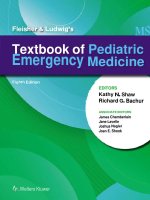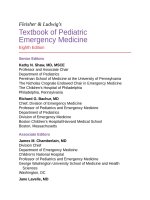Pediatric emergency medicine trisk 0230 0230
Bạn đang xem bản rút gọn của tài liệu. Xem và tải ngay bản đầy đủ của tài liệu tại đây (101.77 KB, 1 trang )
syndrome, structural heart disease, myocarditis, cardiomyopathy, and poisonings.
In children presenting with stable VT, close monitoring and immediate
consultation with a pediatric cardiologist to determine etiology and definitive
treatment is the best management. For children with VT with signs of poor
perfusion (altered mental status, delayed capillary refill, hypotension), begin with
synchronized cardioversion. It is important to recognize that SVT, while typically
narrow complex, can also present with wide-complex tachycardia in some
instances; therefore, in the stable patient with either wide- or narrow-complex
tachycardia, adenosine can be given. For hemodynamically stable patients with
VT, chemical conversion using amiodarone or procainamide could be considered
in conjunction with consultation with an expert.
EXTRACORPOREAL CARDIOPULMONARY RESUSCITATION
There is now some information regarding the use of extracorporeal CPR (E-CPR)
through the use of extracorporeal membrane oxygenation (ECMO) or
cardiopulmonary bypass following CPR to treat refractory cardiac arrest in
children presenting to an ED setting. Currently, it is an option available primarily
in large, tertiary care children’s hospitals. The majority of the literature to date
comes from the treatment of inpatients with primary cardiac disease, and
available studies on use for pediatric IHCA favor the use of E-CPR. The 2010
Guidelines state “There is insufficient evidence to recommend the routine use of
ECPR for patients in cardiac arrest. However, in settings where ECPR is readily
available, it may be considered when the time without blood flow is brief and the
condition leading to the cardiac arrest is reversible or amenable to heart
transplantation or revascularization.” The 2015 Guidelines were changed to state
that “E-CRP may be considered for children with underlying cardiac conditions
who have IHCA” given no clear difference in survival found for ECPR versus
standard CPR for IHCA in noncardiac patients. While the patient and disease
factors which make E-CPR least likely to be effective are still not fully known,
the use of E-CPR may be considered for children who have had a short downtime
and have received high-quality CPR, especially among patients where a cardiac
etiology is suspected, when the resources and personnel are available.
NEWLY BORN INFANT RESUSCITATION
Guidelines for CPR in the newly born infants transitioning from intrauterine to
extrauterine life and for neonates who have completed the transition and require
resuscitation during the first few weeks after birth differ from guidelines for CPR
of older infants and children who present to the ED ( Fig. 9.16 ). For non-newly
born young infants presenting in cardiac arrest, either newly born (NRP)









